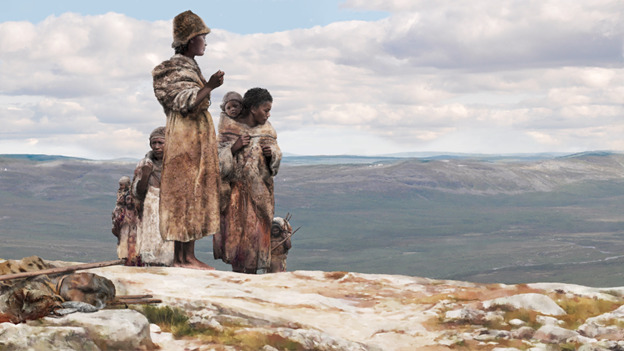Carefully sorting through the detritus — mostly animal bones — of an archaeological excavation that took place in Germany in the 1930s, California State University, Northridge anthropologist Hélène Rougier found inches-long bone fragments that offer a glimpse of what life was like for early modern humans more than 40,000 years ago.
An international team of researchers that includes Rougier was able to sequence the oldest modern human genomes to date and discovered that those early Europeans had recently mixed with Neandertals but left no present-day descendants.
“We’re slowly beginning to build a picture of what life was like for early modern Europeans more than 40,000 years ago,” said Rougier, who teaches in CSUN’s College of Social and Behavioral Sciences. “With each new paper, we learn a little bit more about who they were and where they came from. With each new paper, we find one more piece of the puzzle of what life was like all those years ago.”
Rougier is one of 125 researchers from around the world working together for more than a decade to explore prehistoric life in Europe, hoping to gain perspective on what human life was like before recorded history. Their disciplines span the spectrum, from biological anthropology and archaeology to biochemistry and genetics. The interdisciplinary approach provides an opportunity to bring new perspectives and raise questions that individuals in a particular specialty may not consider or be able to resolve.
The team’s latest findings, “Earliest modern human genomes constrain timing of Neanderthal admixture,” appear in the December 2024 edition of the journal Nature. This latest paper is a continuation of research published by Nature in spring of 2024 that provided evidence — found in the cave Ilsenhöhle located beneath the castle of Ranis in Germany that was first explored by archaeologists in the 1930s — that early modern humans were living and traveling through northwest Europe thousands of years before Neandertals disappeared.
“I was sorting through some of the animal bones that were collected in the cave from that first excavation in the 1930s,” Rougier said. “I have been doing this for a long time, so I was able to recognize that not all the bones were animals. Some belonged to early modern humans. We’re not talking about whole skeletons, but fragments of bones that are more than 40,000 years old.”
Among the bone fragments, which were just inches long, were part of a finger bone and a piece of an infant’s clavicle that were later identified as belonging to a mother and her daughter.
“The DNA in the fragments found in the cave was extremely well preserved,” Rougier said. “The more northern latitudes of Europe you go, the better conditions are for DNA preservation. We were able to extract DNA from all the bones we were able to isolate. There were a couple that didn’t really yield good results, but most of them were really well preserved.”
n all, the researchers were able to analyze the nuclear genomes, the genetic material, of 13 specimens from the Ranis site and found that they represented at least six individuals. The size of the bones indicated that two of the individuals were infants and, genetically, three were males and three were females. Analysis of the nuclear DNA of the bones indicated that members of the group were distant, biological relatives.
Using this information, the researchers compared the DNA of the group found at Ranis to the DNA of a complete skull from a single individual, believed to have lived 45,000 years ago, found at an archaeological site in Zlatý kůň, Czechia, about 230 kilometers away.
To their surprise, the nuclear DNA of the Zlatý kůň skull revealed a fifth- or sixth degree relationship with two of the individuals found at Ranis.
“This means that they were part of an extended family and it is the first time that we are able to detect such a close relationship between ancient bones found at different sites. It means that, at some point, a small group from that family decided to go someplace else, or that the places where we found their remains were part of the territory they occupied,” Rougier said.
Among the six individuals from Ranis, one bone was particularly well preserved. This allowed the team to obtain a high-quality genome from this male individual, referred to as Ranis13. Together, the Ranis13 and Zlatý kůň genomes represent the oldest high-quality modern human genomes sequenced to date. When analyzing genetic variants related to phenotypic traits, the researchers found that the Ranis and Zlatý kůň individuals carried variants associated with dark skin and hair color, as well as brown eyes, reflecting the recent African origin of this early European population, Rougier said.
By analyzing the segments inherited from the same ancestor in the Ranis and Zlatý kůň genomes, the researchers estimate that their population consisted of, at most, a few hundred individuals who may have been spread out over a larger territory. The researchers found no evidence that this small early modern human population contributed to later Europeans or any other world-wide population, Rougier said.
Members of the Zlatý kůň/Ranis population coexisted with Neandertals in Europe, raising the possibility that they may have had Neandertals among their recent ancestors after they migrated to Europe. Previous studies on modern humans from over 40,000 years ago had found evidence of such recent admixture events between modern humans and Neandertals. However, no evidence was found for a more recent Neandertal admixture in the genomes of the Zlatý kůň and Ranis individuals.
Rougier said the Zlatý kůň and Ranis population represents the earliest known divergence from the group of modern humans that migrated out of Africa and dispersed later across Eurasia. Despite this early separation, the Neandertal ancestry in Zlatý kůň and Ranis originated from the same ancient admixture event that can be detected in all people outside Africa today.
By analyzing the length of the segments contributed from Neandertals in the high-coverage Ranis13 genome and using direct radiocarbon dates on this individual, she said the researchers dated this shared Neandertal admixture to between 45,000 and 49,000 years ago.
Since all present-day non-African populations share this Neandertal ancestry with Zlatý kůň and Ranis, this means that around 45,000 to 49,000 years ago, a coherent ancestral non-African population must still have existed, Rougier said.
“What we’re learning, with each new stage of our research, is telling us so much about early modern humans, but there is so much more to learn,” she said. “That’s one of the reasons I really like to work with interdisciplinary teams. None of us could come to conclusions we are alone but together we’re able to discover so much more.”
Like this:
Like Loading...
Related





 Tweet This
Tweet This Facebook
Facebook Digg This
Digg This Bookmark
Bookmark Stumble
Stumble RSS
RSS
































REAL NAMES ONLY: All posters must use their real individual or business name. This applies equally to Twitter account holders who use a nickname.
0 Comments
You can be the first one to leave a comment.